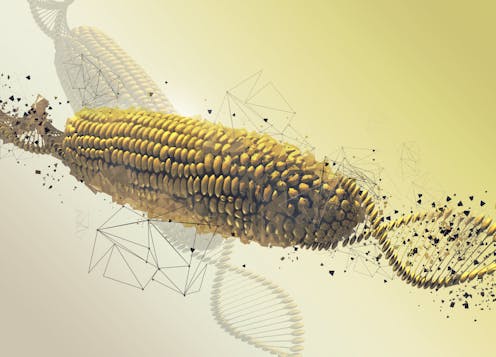
Hunger and undernourishment are two elements of food insecurity that have plagued Africa for years. And the menace is growing.
In 2022, the African region accounted for the highest level of hunger as described by Global Hunger Index. According to the World Health Organization, over 340 million Africans were undernourished and severely food insecure between 2014 and 2020.
Low agricultural productivity and post-harvest losses are some of the reasons.
Evidence from the past two decades suggests that genetically modified (GM) crops could resolve low agricultural productivity, nutrition and food insecurity on the continent.
Scientists have shown that GM technology increases yield, develops disease-resistant crops, and creates varieties that can tolerate drought.
But the technology is controversial. In Africa, only Nigeria, Eswatini, Ethiopia, Malawi, Sudan, South Africa and Kenya allow commercial production and importation of GM products. Other African countries oppose them, largely because of the European Union (EU) stance on GM products, limited scientific capacity and the high cost of regulation.
The EU’s strict regulations on GM products have affected its trade partners, including countries in Africa. Egypt and Burkina Faso, which had commercialised GM maize and cotton in 2008, backtracked on GM partly because of their trade relationship with the EU.
In 2013 I led the largest study in the history of GM agriculture in Africa. It provided new perspectives on the status, development and regulation of GM crops, through the views of 305 stakeholders in six African countries.
In the study, my team and I developed a framework for adopting GM crops which we called fibre-feed-food (F-3). The F-3 framework adopts GM cotton (fibre) first, followed by GM feed for livestock, then GM food. It ensures that all necessary risk assessments are carried out between GM cotton and GM feed before producing GM food for human consumption. And it helps familiarise farmers and the public with new technology and allay their concerns about safety.
The framework has helped more than 30 African countries conduct GM crop field trials. GM products undergoing research and development include vitamin A-fortified cassava and potatoes, bacterial wilt-resistant banana and water-efficient maize, among others.
Based on my research in this area I believe that agricultural innovations such as GM crops or organisms have the potential to address food insecurity in Africa.
The promise of GM crops
The technology is already contributing to global food security. A report by the International Service for the Acquisition of Agri-biotech Applications credits GM technology for the global production of 330 million tonnes of soybean and 595 million tonnes of maize over the past 25 years. The adoption of GM technology among cotton producing households in India reduced food insecurity by 15%-20% between 2004 and 2008.
Research into the value gained from planting GM crops has shown that 65% of the gain came from higher yield and production and 35% from lower costs.
Farmers in developing countries have enjoyed over half of the global value gain of US$186.1 billion since the mid-1990s. In 2019, Brazil, Argentina, India, Paraguay and China were among the 10 countries that planted the most GM crops in the world.
GM technology also offers higher nutrient content in crops. For example, a trial of sweet potato bio-fortified with pro-vitamin A succeeded in Mozambique and the product was accepted by young children. This potentially improves child health.
GM crops showed environmental benefits by reducing greenhouse gases and pesticide use in developed countries. For example, a 2020 study suggested that GM technology worldwide prevented the emission of 23.6 billion kilograms of carbon dioxide. It means that the technology can help tackle global warming.
Obstacles to GM crops in Africa
In spite of these benefits, GM crops have not been widely adopted in Africa. Efforts to create and commercialise GM products still face stiff opposition. Uganda and Nigeria, for example, face strict regulation, limited research capacity and safety concerns.
In Uganda, a biosafety regulatory logjam, lack of awareness and politics undermine the application of GM technology. Different national biosafety policies have emerged over the past decade.
Potential risks of GM crops have led to the review and amendment of GM laws. The risks include gene flow (genes being transferred to another population), biodiversity loss and health related concerns. In 2018, a bill to regulate GM organisms in Uganda failed to be passed into law. The failure derived from disagreement between the Ugandan parliament and the president. The overwhelming majority of parliament cited risks as the reason for outlawing GM organisms in the country.
The scientific community, led by the Ugandan National Agricultural Research Organisation, argues that regulations would facilitate research and development. Then there would be information to base decisions on. A decision to adopt organisms such as GM banana, for example, might reduce malnutrition and poverty.
Read more: Genetically modified cowpea clears its first hurdle in Ghana, but there's a long way to go
In Nigeria, a national biosafety bill was passed into law and approved by the former president, Goodluck Jonathan, in 2019. Nigeria then commercialised GM cotton. This was followed by GM cowpea to control pod borer insects, which account for a 70%-80% loss of cowpea yield annually.
Cowpea is a major source of protein and energy, especially for rural dwellers. Yet some scientists, environmentalists and consumers in Nigeria are still wary of GM cowpea. They argue that it could eradicate the use of traditional cowpea and farmers might not be able to afford the price of GM cowpea varieties.
Other scientists and agro-biotech companies believe that GM cowpea can reduce food scarcity and offer nutritional benefits. Acceptance depends a lot on local evidence. And that requires scientific capacity and partnerships with private research institutes.
What must be done
Resilient food systems require a wide range of existing and new agricultural technologies, including GM organisms. There are several ways to encourage uptake:
increase investment in research and innovation for agricultural biotechnology
educate and train scientists
get local scientists involved in setting the research agenda and providing evidence to inform national decision making
exchange ideas and information across different levels of government
create awareness through science communication informed by local evidence of benefits and concerns.
Policy, research and science communication must align. The goal is to ensure GM foods are safe to eat, and help end hunger and malnutrition.
Ademola Adenle does not work for, consult, own shares in or receive funding from any company or organisation that would benefit from this article, and has disclosed no relevant affiliations beyond their academic appointment.
This article was originally published on The Conversation. Read the original article.







